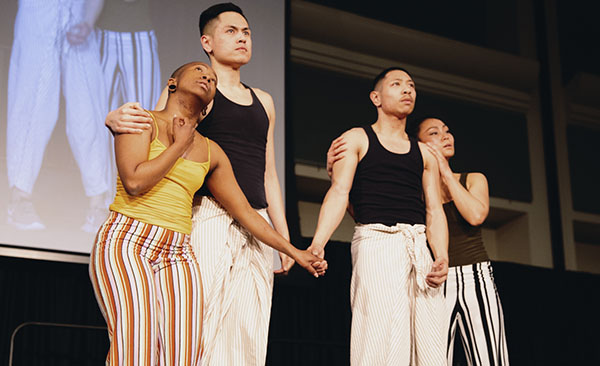 Members of Sacramento/Black Art of Dance perform at the gathering Monday, March 4, in the University Union Ballroom, contributing their artistry to the Sac State's consideration of the Stephon Clark tragedy. (Sacramento State/Jessica Vernone)
Members of Sacramento/Black Art of Dance perform at the gathering Monday, March 4, in the University Union Ballroom, contributing their artistry to the Sac State's consideration of the Stephon Clark tragedy. (Sacramento State/Jessica Vernone)Sac State President Robert S. Nelsen discussed the pain and tension surrounding the Stephon Clark case on Monday morning, calling on members of the campus community to rally around one another and seek healing.
Then students, alumni and faculty took the stage for artful performances that offered various perspectives on Clark, an unarmed black man who was shot and killed by Sacramento police nearly a year ago in his grandmother’s backyard. The death sparked widespread protests and calls for police reform.
Nelsen originally had planned to use his spring address to answer previously submitted questions about Sac State in a Town Hall format. He changed the theme in anticipation of an announcement by the Sacramento County District Attorney’s Office about whether the DA would charge the officers who shot Clark.
The DA, Anne Marie Schubert, on Saturday, March 2, announced the officers would not be held criminally liable in Clark's death. She said officers feared for their lives when they shot Clark after a foot chase in the Meadowview neighborhood.
Schubert's announcement “is too heavy to simply ignore,” Nelsen told more than 300 people gathered in the University Union ballroom.
“Questions will always remain. Did his death have to happen? Wasn’t there a better way? Sac State has to be part of that better way.”
Campus leaders “who have spent their careers working on transparency, accountability in government and policing, and in eradicating poverty and improving our communities” will guide a larger discussion about the University’s role going forward, he said.
“I regret that we have not done more on campus to address the trauma that many of you are feeling from the loss of this young man and to confront the ongoing issues of race and justice in our community and country,” Nelsen said.
This week, the campus is hosting “healing spaces” at the Multicultural Center and the MLK Center for people seeking comfort in light of the DA’s decision.
A small student contingent was on hand Monday to protest the outcome of the Clark case.
While Nelsen spoke, two Sac State students silently displayed a large sign with the words “No Harm, Disarm.”
Students Martha Ancajas and Yahaira Victorino later said they are members of a group, CSU Students for Quality Education, that uses social activism and protest to fight for rights and equality. “No Harm, Disarm,” which is tied to the Clark case, is one of its campaigns.
“When something like this happens, the whole community is harmed,” said Ancajas, an ethnic studies major. She said the group is planning further actions in the near future to draw attention to the case and to the needs of underserved communities.
The arts performances on Monday used rap, dance and drama to portray various views of the Clark case.
They included pieces by “Come.Unity,” featuring choreography by Assistant Professor Bernard Brown; student members of the “A Memory, A Monologue, A Rant and A Prayer” cast; and Hornet alum DeWayne LaMont, who is known in the arts community as Consci8us.
“We can say Black Lives Matter,” Consci8us rapped. “But we see black lives shatter every day.”
The performances, Nelsen said, offered “a chance for the arts to heal us … a chance to come together and understand things that are clouding our vision and our minds.”
“I hope that we can come together to support one another during this painful time in our community,” he said. – Cynthia Hubert
